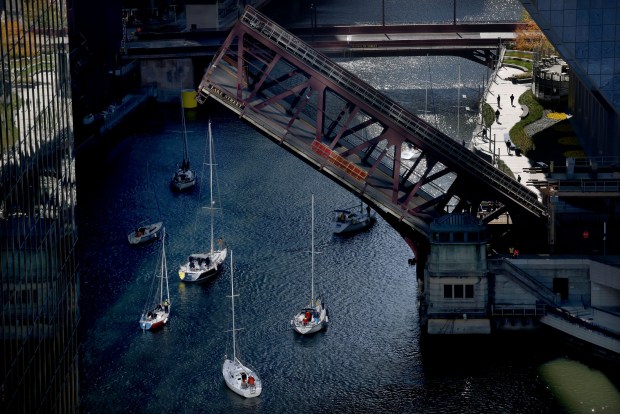The man with a briefcase was stunned for a moment. Getting out of a cab early sunny Monday morning at State Street and Wacker Drive, he had obviously not heard the news. He stared for a while at the large declarative signs nearby, “Bridge Closed” and “Sidewalk Closed.” Then he shrugged his shoulders and said, as he started walking east, “OK, then. It’s Wabash for me.”
And it will be for a while. Those signs and some barricades signaled that the city’s Department of Transportation had commenced what it deems emergency repair work on the State Street Bridge above and over the Chicago River. The bridge is closed to all vehicular and pedestrian traffic for the removal and replacement of floor beams, rehabilitation of multiple center lock components, and viaduct repairs north of the bridge. It is scheduled to be finished by mid-November, but you know how these things go.
Tens of thousands of us cross our bridges every day without an ounce of notice or appreciation.
The river? We love the river. The river is why we are here; it has for hundreds of years played a crucial role first for transportation, fishing, and farming and later as a shortcut between the Mississippi River and Lake Michigan, creating Chicago. It is a magnificent thing, 50 miles in length along its three branches, taking a hard left at Wacker Drive and later flowing into the Illinois and Michigan Canal and Chicago Sanitary and Ship Canal, then into the Des Plaines River and, eventually, winding up in the Gulf of Mexico. It is 21 feet deep at its deepest point and 800 feet wide at its widest.
But why not take a minute and consider our bridges?
Maybe this will help: There is not a city in the world — not Paris, not Venice — with more movable bridges than Chicago. There are 52 of them over the river.
As an alternative to using canoes to get across, people built the first bridge in 1831 across the North Branch. It was meant to allow easy access to and less dangerous egress from a saloon. The bridge didn’t last long, but in 1834 came the city’s first movable bridge, a drawbridge at Dearborn Street which, legend has it, got stuck so often that it was chopped up to be used as firewood.
All sorts of bridges and designs were featured across the river during the following decades of the 19th century. They were swing bridges, jackknife bridges, vertical lift bridges, rolling lift bridges. By the mid-1880s, 35 movable bridges spanned the river.
Then in 1902, the Cortland Street Bridge became the first trunnion bascule bridge ever built. Essentially a drawbridge with two halves that moved, this design (bascule is French for “seesaw”) became known as a “Chicago-style bridge” and was the dominant design for all bridges that followed.
My favorite has long been the Michigan Avenue Bridge, built between 1917 and 1920, the work of architect Edward Bennett. Have a look, if you never have, at the relief sculptures that adorn the pylons that sit at each of the bridge’s corners: “The Pioneers,” with John Kinzie, one of the city’s first settlers (northwest); “The Discoverers,” marking the exploits of explorers Marquette and Joliet (northeast); “Defense,” depicting the Battle of Fort Dearborn (southwest); and “Regeneration,” honoring the city’s rebuilding after the fire of 1871 (southeast).
Sometimes I will walk down the stairs and cross the bridge on its lower level, where I am quickly hit with the cinematic memory of Eliot Ness (Kevin Costner) meeting cop Jim Malone (Sean Connery) in the 1987 film “The Untouchables,” screenplay by Chicago’s own David Mamet.
From the bridge, you can hear the past whisper of the Native Americans who found skunk cabbage and wild onion on its banks and affixed to this site the Indian name for those earth products, Checagou, and of the engineering geniuses who reversed the river’s flow in 1900 to keep the lake clean.
And I always recall an old journalism tale.
Many years ago, the story goes, a reporter was sent out on assignment but failed to return at the appointed hour, missing his deadline because he had spent the afternoon in a cozy saloon.
When he got back to the office, an angry editor shouted, “Where the hell have you been? You were supposed to file your story by noon. It’s already past six. Why weren’t you here? Where were you?”
“The bridge was up,” said the reporter.

Few people have appreciated the bridges more than writer Janice Rosenberg, who wrote of them in the 1991 magazine of the Chicago Historical Society (now the Chicago History Museum), saying, in part, “Viewed from all directions, Chicago’s bridges are works of art as well as wonders of modern engineering.”
And now, one last thing as the work crews get to work and commuters adjust: The State Street Bridge is not the State Street Bridge.
Its scheduled 1939 opening was delayed due to material shortages caused by World War II. When finally dedicated on May 28, 1949, it was formally named the Bataan-Corregidor Memorial Bridge.
There is a plaque that reads, “Dedicated to the memory of those gallant heroes from the Chicago area who were members of the besieged garrison of the Bataan peninsula and at Corregidor, Philippine Islands, in World War II. May the courage and fortitude displayed by this group in the face of adversity be a constant inspiration to our citizens.”
rkogan@chicagotribune.com



